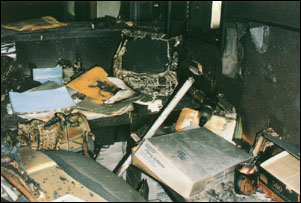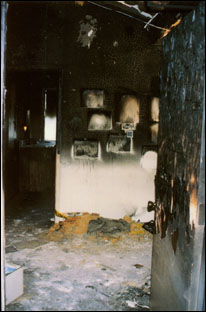
The physicians in this practice didn't think disaster would strike. Learn from their experience and don't get caught unprepared.
Fam Pract Manag. 1999;06(8):33-35
Two destructive office fires occurred within three months in our small community of Silverton, Ore., and one of the casualties was our two-doctor family practice. We never dreamed that something like this would happen to us. In fact, a fire or any other threat of disaster seemed so implausible that we never gave a disaster plan much thought — that is, until early one Sunday afternoon, when material in a trash can ignited and sent our practice, as we knew it, up in smoke. During the next four months, as we rebuilt our office, we learned what we should have done to better protect ourselves and our patients. With luck, and good planning, you'll be more prepared than we were.
The damage and its aftermath
Our first look inside the clinic after the fire was by flashlight. The clinic's windows were black with smoke. The glass in the framed pictures and diplomas on the walls had shattered from the heat. Most of the fluorescent light fixtures on the ceiling had melted onto the exam tables and the floor. The phones, computers and even the copier had also melted and were almost unrecognizable. Tarps covered some of our charts; the rest were in a pile on the floor and were badly charred. The extent of the damage left us numb, and it was difficult to absorb the news that we'd be out of our office for several months.

However, we knew we had to act. The first hurdle we faced was finding a temporary location for our practice. A surgeon in the building next door was leaving on vacation and offered to let us use his office while he was away. It was small and crowded, but we were nonetheless grateful to be open for urgent appointments only 20 hours after the fire.
Using our neighbor's facility worked in the short run, but we needed a temporary office for the months between his return from vacation and the completion of the work on our office. Several family physicians kindly offered us space, but my partner and I declined because we couldn't justify splitting up charts, telephones and staff among several buildings. Instead, we accepted the local hospital's offer of a three-bedroom house. With intense effort by our dedicated staff, we moved into this makeshift office only a week after the fire.
We advertised our temporary location in the newspaper (an ad that surprisingly few said they saw) and put professionally made signs on the burned building and on our temporary office. Despite these efforts, many patients still weren't aware of our new location, and we had to build extra time into our schedules to allow for late arrivals.
Before moving into the house, we also considered renting a modular building. A colleague, who has since been through a similar experience, rented one that was approximately twice the size of our temporary office. The downside of this approach was that it would have taken two weeks to set up a modular building and would have cost approximately four times what we paid to rent the house. In hindsight, however, it might have been worth the cost because our colleague was able to maintain his usual level of productivity. Our production fell at least 30 percent during the four months we were displaced. Because we didn't have enough exam rooms to accommodate both of us, my partner and I had to stagger our work hours. We also didn't have the space to do lab work, X-rays or procedures. Fortunately, our insurance covered our income loss. (We strongly recommend insurance to cover loss of net income resulting from a disaster.)
The telephone has always been the lifeline of our practice, so our next priority was setting up a phone system in our temporary location. Because the work space wouldn't allow for our usual staffing level, we had to limit the number of incoming lines. Patients had to put up with more busy signals, but fewer phone lines turned out to be a livable compromise for everyone.
In addition to cutting into our income and limiting our telephone access, our situation took its toll on our staff members. Although they adjusted well to working in our temporary facility, four months of tight quarters was, admittedly, a little hard on morale.
Key Points:
Your practice's disaster insurance should cover replacement of the building and contents, code upgrades, records restoration and loss of net income.
Increase the coverage on your insurance policy as your practice grows.
Equip your practice with smoke detectors, and consider installing a sprinkler system.
It can happen to you. Develop a disaster plan, and take precautions now.
Rebuilding the practice
Once we had settled into our temporary location, we began to focus on the formidable task of restoring our patient records. All our records were smoke-damaged and partially charred, but luckily they were, for the most part, legible. First, we moved all our inactive records to a secure, dry storage area where they could be accessed when needed. Then we photocopied each page of our active records and color-coded the file folders to correspond to the first letter of the patients' last names, hoping to reduce the number of misfiled charts in the future. To accomplish this huge task, we rented space in a vacant fast-food restaurant, shifted as many office staff members as we could spare, hired temporary office personnel and received help from some reliable volunteers. We estimate that this project took more than 800 work hours to complete and cost about $24,000.
One of the best decisions we made was designating our office manager to act as the contact person with the insurance company, construction crew and everyone else involved in rebuilding our practice. This freed up the rest of us to take care of patients without frequent interruption. (However, since our office manager is also our medical assistant, we had to reassign her duties temporarily to a lab technician.) My partner and I still made the big decisions, but our contact person served as our conduit to the nonclinical work going on around us.

Our insurance lessened the financial bite of the fire considerably. In addition to covering the lost income, our policy covered the replacement cost of our building and equipment, as well as our records restoration. To help us track the payments from the insurance company and make sure that our suppliers and the construction company were paid promptly, we had the insurer issue all checks directly to the practice.
Unfortunately, our insurance didn't cover the code upgrades we made to the building after the fire. While code upgrades are generally available as a rider on an insurance policy, our insurer didn't offer this rider at the time of our fire. Consequently, we spent about $13,000 out-of-pocket upgrading electrical wiring and improving access to the building for people with disabilities.
We would have had higher out-of-pocket expenses if the fire had completely destroyed the contents of our practice. We had neglected to keep increasing the coverage on equipment replacement as our practice grew, and we avoided exceeding our $136,000 loss limit only by refurbishing some furniture and equipment, rather than replacing it, and by choosing not to replace some of our bigger-ticket items. If we had replaced everything, we would have had been about $20,000 short.
Regrets
In addition to failing to increase our insurance coverage, one of our big regrets is that we didn't keep an up-to-date running inventory list. It would have been a blessing not only to help us itemize our losses but also to remind us just how valuable our office contents had become. Instead, we relied on our practice's accountant for a depreciation schedule of our equipment, our medical supplier for a printout of our orders for the past nine months and our medical assistant for a mental walk-through of our office so that we could begin to restock.
Another regret is that we didn't have smoke detectors wired into our security system. Although our office was equipped with fire extinguishers and our staff members knew how to use them, that preparation didn't help us since the fire started when the office was closed. Our motion detector actually alerted the authorities, but they lost valuable minutes before they realized that it was a fire and not an intruder that had triggered the alarm. We wired in our smoke detectors after the fire but chose not to install a sprinkler system because of its potential to cause water damage.
We'd also become lax about the security of our computer back-up tape, too often leaving it in the office. Although our data did survive the fire, we now make sure that we store the daily back-up tape off-site.
A silver lining
After four months of inconvenience, we're now practicing in our newly remodeled office. It looks terrific, and we're happy to have the space and equipment that our temporary location lacked. In hindsight, we wish we had reviewed our insurance more regularly and developed a disaster plan before the fire [see “Could Your Office Cope With Disaster?”]. But at least, with the help of our staff and community, we were able to care for our patients without interruption.